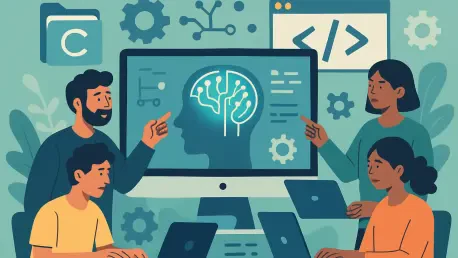The realm of artificial intelligence is undergoing a profound transformation with the unveiling of the LLM Open Source 2.0 ecosystem map at the Bund Summit in Shanghai on September 13, marking a pivotal moment for large language model development. This updated “Panoramic Map of the Large-Model Open-Source Development Ecosystem,” crafted by Ant Group’s Open-Source Technology Growth team, paints a vivid picture of an industry in flux, with 60 projects phased out and 39 fresh initiatives introduced. Spanning 114 projects across 22 distinct fields, the map captures the blistering pace of innovation that defines this space. It’s a landscape where obsolescence strikes swiftly, and even once-dominant tools must adapt or fade into irrelevance. This transformation isn’t just about numbers—it’s a testament to a dynamic ecosystem driven by youthful energy and relentless progress, setting the stage for a deeper exploration of how these shifts are reshaping AI development on a global scale.
Beyond the raw data lies a story of rapid evolution, where the median age of projects hovers at a mere 30 months, and the average lifespan barely stretches past three years. Such statistics highlight an environment of constant reinvention, where staying relevant demands agility and foresight. The decline of a heavyweight like TensorFlow, now overshadowed by PyTorch, serves as a stark reminder of how quickly technological tides can turn. As new paradigms emerge, the focus sharpens on specialized areas like the AI Agent layer, which has become a crucible of innovation. This ever-changing landscape, fueled by both technological breakthroughs and geopolitical dynamics, invites a closer look at the forces driving this transformation and the implications for developers and enterprises alike.
Pioneering Advances in AI Agents
Unleashing Creativity in Application Layers
The AI Agent layer stands as a beacon of innovation within the open-source ecosystem, often likened to a “Cambrian explosion” due to the sheer diversity and speed of new developments. What was once a disparate collection of tools has evolved into a structured hierarchy, mirroring the frameworks of cloud computing. AI Coding, a standout segment within this layer, has undergone a remarkable transformation, moving far beyond basic code completion. Today, it functions as a full-lifecycle intelligent engine, capable of supporting every stage of development, from ideation to maintenance. Features like multi-modality and team collaboration are no longer futuristic concepts but tangible realities that enhance productivity. This shift signals a profound change in how developers interact with technology, positioning AI as a true partner in the creative process. The implications of this trend extend beyond technical advancements, hinting at a future where such tools redefine workflows across industries.
Equally striking is the commercial promise embedded in these advancements, particularly within AI Coding tools that are paving the way for new revenue models. Subscription-based services and Software-as-a-Service (SaaS) platforms are emerging as viable paths to monetization, capitalizing on the demand for sophisticated features. However, this potential is not without its challenges. Large technology corporations are increasingly leveraging open-source toolchains to anchor developers to proprietary ecosystems, a strategy reminiscent of historical tactics by industry giants. This dynamic raises critical questions about the balance between fostering open innovation and succumbing to corporate control. As AI Agents continue to dominate the innovation landscape, the tension between accessibility and exclusivity becomes a central theme. The trajectory of this layer will likely influence not just technical standards but also the ethical framework within which AI development operates globally.
Navigating the Commercial and Ethical Landscape
The commercial allure of AI Agents, especially in AI Coding, is undeniable as these tools transition from niche utilities to indispensable assets for developers worldwide. Their ability to streamline complex processes—such as debugging, deployment, and ongoing maintenance—has sparked interest from both startups and established firms eager to tap into this market. Paid subscriptions and value-added features offer a glimpse into a future where profitability and innovation go hand in hand. Yet, beneath this optimism lies a concern about sustainability. The rapid pace at which projects emerge and vanish suggests that only those with robust community support and continuous updates will thrive. This environment demands that developers and companies alike remain vigilant, adapting to user needs and technological shifts to maintain relevance in a crowded field.
Meanwhile, the strategic maneuvers of tech giants cast a shadow over the open-source ethos that underpins much of this ecosystem. By integrating open-source tools with proprietary systems, these corporations risk creating a dependency that could stifle independent innovation. Historical parallels to strategies employed by major players in the software industry serve as a cautionary tale, highlighting the need for vigilance among developers and policymakers. The ethical implications of such trends are profound, prompting a broader discussion about how to preserve the collaborative spirit of open-source while navigating commercial interests. As this layer continues to evolve, striking a balance between monetization and openness will be crucial to ensuring that the benefits of AI Agents are accessible to a wide array of contributors and users.
Shifting Technological Paradigms and Ecosystem Evolution
From Legacy to Innovation in Frameworks
A defining feature of the current AI landscape is the dramatic shift in technological dominance, epitomized by the decline of TensorFlow in favor of PyTorch as the preferred machine learning framework. This transition is more than a change in tools; it reflects a broader trend where adaptability and community engagement dictate relevance. TensorFlow, once a cornerstone of AI development, has struggled to keep pace with the dynamic needs of modern developers, while PyTorch’s flexibility and active support have propelled it to the forefront. This shift mirrors the broader ecosystem’s volatility, where the elimination of 60 projects from the 2.0 map underscores the harsh reality of obsolescence. Staying ahead in this space requires not just innovation but a deep connection with the user base, a lesson that resonates across all layers of AI development as new standards emerge.
The high turnover rate within the ecosystem further amplifies this narrative of relentless change, painting a picture of a survival-of-the-fittest environment. Projects like NextChat and GPT4All, once prominent, have faded due to sluggish iteration and insufficient community backing, making way for newer entrants that capture attention with fresh ideas. Many of these emerging initiatives, born after significant milestones in AI history, have garnered remarkable engagement on platforms like GitHub, averaging nearly 30,000 Stars. This level of interest signals a vibrant community eager for cutting-edge solutions, but it also highlights the pressure on projects to deliver consistent value. As older tools fall by the wayside, the focus shifts to fostering environments where innovation can flourish without the looming threat of rapid irrelevance, a challenge that will define the next phase of growth in this field.
Refining Insights Through Data-Driven Mapping
The methodology behind the 2.0 map represents a significant leap forward in understanding the open-source ecosystem, transitioning from subjective selections to a rigorous, data-centric approach. By leveraging GitHub’s OpenRank rankings with a stringent entry threshold of OpenRank > 50, this updated framework ensures a more objective representation of impactful projects. Such a shift uncovers high-potential emerging tools that might have been overlooked under previous methods, providing a clearer picture of where innovation is headed. For enterprises and developers, this refined approach offers actionable insights, enabling better decision-making in a landscape characterized by rapid change. The emphasis on data also aligns with the broader trend of systematization within AI, where structured analysis becomes as critical as the technology itself.
Beyond its immediate utility, this methodological evolution reflects a maturing field that seeks to balance chaos with clarity. The comprehensive nature of the 2.0 map addresses past limitations, ensuring that both established players and newcomers are evaluated on equal footing. This inclusivity not only enhances the map’s credibility but also mirrors the ecosystem’s own drive toward fairness and transparency in recognizing contributions. As a tool for navigation, it serves a dual purpose—guiding strategic investments for companies while empowering individual developers to identify trends and opportunities. The focus on data-driven insights is likely to set a precedent for future mappings, ensuring that the ecosystem’s complexity is matched by equally sophisticated tools for understanding it, ultimately fostering a more informed and connected community.
Global Dynamics and Future Trajectories
Powerhouses Shaping the AI Landscape
On the global stage, the United States and China emerge as titans in the LLM open-source ecosystem, collectively accounting for over 55% of developer contributions worldwide. The U.S. holds a commanding lead in foundational areas like AI infrastructure, with a contribution rate of 43.39%, and excels in data management, underscoring its strength in building the backbone of AI technologies. Meanwhile, China demonstrates formidable prowess in application layers, particularly AI Agents, with a contribution rate of 21.5%, closely trailing the U.S. at 24.62%. This dichotomy reveals distinct national priorities—while one focuses on creating robust platforms, the other drives innovation in practical, user-facing solutions. Such a balance of power fuels a competitive yet complementary dynamic, shaping the trajectory of AI advancements on a worldwide scale.
This geopolitical rivalry extends beyond mere numbers, influencing how innovation unfolds in different regions. The U.S. benefits from a long-standing tradition of research and investment in core technologies, which provides a stable foundation for experimentation. In contrast, China’s emphasis on application-driven development reflects a strategic focus on scalability and immediate impact, particularly in consumer-facing AI tools. Both approaches contribute uniquely to the ecosystem, yet they also highlight potential areas of tension, as differing priorities could lead to fragmented standards or competing frameworks. As these two nations continue to dominate, their influence will likely steer global policies, investment patterns, and collaborative efforts, making their interplay a critical factor to watch in the coming years.
Envisioning Sustainable Growth Amid Competition
Looking ahead, the intense competition between global leaders raises important considerations for sustainable growth within the AI open-source ecosystem. The rapid turnover of projects, while a sign of vitality, also poses risks of instability if not matched by mechanisms that support long-term viability. Encouraging robust community engagement and ensuring that new projects receive adequate resources could mitigate the high failure rate seen in recent mappings. Additionally, fostering international collaboration might help harmonize the diverse strengths of contributing nations, reducing the risk of siloed advancements. The challenge lies in creating an environment where innovation thrives without sacrificing the accessibility that open-source principles promise.
Equally vital is addressing the strategic plays by large corporations that threaten to undermine the ethos of openness. As tech giants integrate open-source tools into proprietary systems, there’s a pressing need for frameworks that protect developer autonomy while still allowing for commercial exploration. Policymakers, industry leaders, and communities must work in tandem to establish guidelines that prevent monopolistic tendencies from overshadowing collaborative progress. Reflecting on past shifts, such as the decline of once-dominant frameworks, it’s clear that adaptability was key to survival. Moving forward, embracing a similar mindset—coupled with a commitment to ethical standards—will be essential in navigating the complexities of this evolving landscape, ensuring that the transformative potential of AI benefits a broad spectrum of stakeholders.









